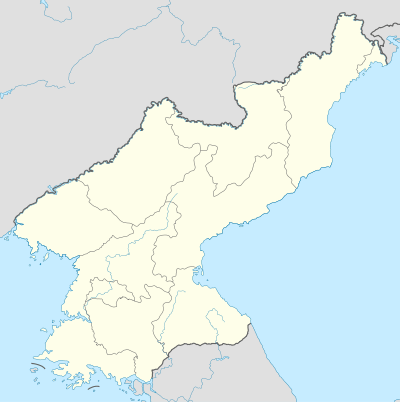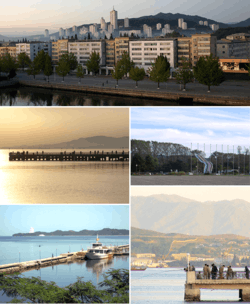Wonsan
| Wŏnsan 원산시 | |
|---|---|
| Municipal City | |
| Korean transcription(s) | |
| • Chosŏn'gŭl | 원산시 |
| • Hancha | 元山市 |
| • McCune-Reischauer | Wŏnsan-si |
| • Revised Romanization | Wonsan-si |
|
View of Wonsan | |
 Wŏnsan | |
| Coordinates: 39°08′51″N 127°26′46″E / 39.14750°N 127.44611°ECoordinates: 39°08′51″N 127°26′46″E / 39.14750°N 127.44611°E | |
| Country |
|
| Province | Kangwŏn |
| Region | Kwandong, Kwannam (before 1946) |
| Settled | c. 1800 |
| Divisions | 45 dong, 14 ri |
| Area | |
| • Total | 269 km2 (104 sq mi) |
| Population (2000 (Est.)) | |
| • Total | 331,000 |
Wŏnsan is a port city and naval base located in Kangwŏn Province, North Korea, along the eastern side of the Korean Peninsula, on the Sea of Japan (East Korean Sea) and the provincial capital. The port was opened by occupying Japanese forces in 1880. Before the Korean War (1950–1953), it fell within the jurisdiction of the then South Hamgyŏng province, and during that war, it was the location of the Blockade of Wŏnsan. The population of the city was estimated at 331,000 in 2000. Notable people from Wŏnsan include Kim Ki Nam, diplomat and Secretary of the Korean Workers' Party. Economically, the city is home to several major factories.
In 2013, it was announced that Wŏnsan will be converted into a summer destination with resorts and entertainment.[1]
Name
Wonsan has also been known as Yonghunghang, Yuan shan in China, Genzan or Gensan in Japan, and Port Lazareva or Port Lazareff in Russia.
Geography

Wŏnsan's area is 269 square kilometres (104 sq mi). It is located in Kangwŏn Province, on the westernmost part of the Sea of Japan (East Sea of Korea) and the east end of the Korean peninsula's neck. Mt. Changdok (Changdok-san) and Mt. Nap'al (Nap'al-san) are located to the west of the city. More than 20 small islands flank Wŏnsan's immediate coastal area, including Hwangt'o Island and Ryŏ Island. Wŏnsan is considered an excellent natural port location. Kŭmgang-san mountain is located near Wŏnsan.
Administrative Divisions
Wŏnsan serves as the administrative centre of Kangwŏn Province.
The City of Wŏnsan (Wŏnsan-si) is divided into 45 tong (neighbourhoods) and 14 ri (villages):
|
|
|
Climate
The city has a borderline humid subtropical climate (Köppen Cwa/Cfa) that is very close to a humid continental climate (Dwa/Dfa).
| Climate data for Wonsan, North Korea | |||||||||||||
|---|---|---|---|---|---|---|---|---|---|---|---|---|---|
| Month | Jan | Feb | Mar | Apr | May | Jun | Jul | Aug | Sep | Oct | Nov | Dec | Year |
| Average high °C (°F) | 2.0 (35.6) |
4.7 (40.5) |
10.0 (50) |
16.5 (61.7) |
20.9 (69.6) |
24.6 (76.3) |
26.7 (80.1) |
27.3 (81.1) |
23.1 (73.6) |
18.9 (66) |
11.2 (52.2) |
4.6 (40.3) |
15.8 (60.4) |
| Daily mean °C (°F) | −1.8 (28.8) |
0.4 (32.7) |
5.8 (42.4) |
12.1 (53.8) |
16.5 (61.7) |
20.8 (69.4) |
23.9 (75) |
24.5 (76.1) |
19.7 (67.5) |
14.6 (58.3) |
7.3 (45.1) |
1.0 (33.8) |
12.1 (53.8) |
| Average low °C (°F) | −5.5 (22.1) |
−3.6 (25.5) |
1.7 (35.1) |
7.7 (45.9) |
12.2 (54) |
17.1 (62.8) |
20.9 (69.6) |
21.4 (70.5) |
16.3 (61.3) |
10.5 (50.9) |
3.6 (38.5) |
−2.6 (27.3) |
8.3 (46.9) |
| Average precipitation mm (inches) | 36.8 (1.449) |
25.3 (0.996) |
23.1 (0.909) |
40.8 (1.606) |
80.1 (3.154) |
135.1 (5.319) |
280.2 (11.031) |
211.1 (8.311) |
213.1 (8.39) |
120.1 (4.728) |
55.9 (2.201) |
27.8 (1.094) |
1,249.4 (49.189) |
| Average precipitation days | 5.4 | 3.8 | 4.6 | 6.8 | 8.0 | 12.1 | 15.4 | 12.5 | 10.5 | 7.0 | 5.8 | 3.5 | 95.4 |
| Mean monthly sunshine hours | 204.6 | 206.2 | 232.5 | 234.0 | 235.6 | 207.0 | 173.6 | 176.7 | 198.0 | 223.2 | 192.0 | 192.2 | 2,475.6 |
| Source #1: Weather OnLine[2] | |||||||||||||
| Source #2: Wetter Spiegel Online (sunshine only)[3] | |||||||||||||
History

Wŏnsan opened as a trade port in 1880. Its original name was Wŏnsanjin (元山津), but it was also known by the Russian name of Port Lazarev (Lazaref). Under Japanese rule (1910–45) it was called Gensan (元山). In 1914 the P'yŏngwŏn and Kyŏngwŏn railway lines were opened, connecting the city to P'yŏngyang (then known as Heijo) and Seoul (then Keijo or Kyŏngsŏng). Thus, the city gradually developed into the eastern product distribution centre. Under the Japanese occupation, the city was heavily industrialized and served as an import point in the distribution of trade between Korea and mainland Japan.
Provincial borders
Wŏnsan used to be in South Hamgyŏng, but when provincial borders were redrawn in 1946, it joined the northern half of Kangwŏn (which had been split at the 38th parallel north into a zone under Soviet control in the north and one of American control in the south in 1945) and became its capital, as Kangwŏn's traditional capitals Wŏnju (1395–1895) and Ch'unch'ŏn (since 1896) both were south of the 38th parallel and south of the Military Demarcation Line that replaced the 38th parallel as a border in 1953. It was heavily bombed by the United Nations during the Korean War's Blockade of Wŏnsan.[4] In fact, according to the official US Navy history, Wŏnsan was under continuous siege and bombardment by the American navy from March 1951 until July 27, 1953, making it the longest siege in modern American naval history. By war's end the city was a vast shell.[5] It was also captured by American and South Korean troops on 10 October 1950, when they left. It was under control by the Chinese ones on 9 December 1950.
Economy
Wŏnsan has an aquatic product processing factory, shipyard, chemistry enterprise, and a cement factory.
Transportation
- Road and rail
The district of Wŏnsan-si is served by several stations on the Kangwŏn Line of the Korean State Railway, including a branch to the port; it is also connected to the national road network, and is the terminus of the P'yŏngyang-Wŏnsan Tourist Motorway and the Wŏnsan-Kŭmgangsan Highway.
- Air
The city has the dual purpose military and civilian Wŏnsan Airport (IATA: WON) equipped with 01/19 and 15/33 dual runways. Images from Google Earth from July and August 2014 indicated that major expansion was taking place, including the construction of two new runways.[6]
- Sea
Wŏnsan is also the terminus of the Mangyongbong-92 ferry that operates between Wŏnsan and Niigata, the only direct connection between Japan and North Korea.
Media
The Korean Central Broadcasting Station maintains a 250-kilowatt mediumwave transmitter broadcasting on 882 kHz AM.
Education
Wŏnsan is home to Songdowŏn University, Kŭmgang University, Tonghae University, Jong Jun Thaek University of Economics, Wŏnsan University of Medicine, Jo Gun Sil University of Engineering, Wŏnsan First University of Education and Ri Su Dok University.
Sports
The city is home to Unp'asan Sports Club, a football (soccer) club that plays in the DPR Korea First Class Sports Group, North Korea's premier league.
Tourism
Wŏnsan is a popular tourist destination for foreigners and locals alike,[7] nearby Songdowŏn is a famous sea bathing destination in North Korea, as the water there is exceptionally clear. Pine trees are abundant in the surrounding area, and it has been designated a national sightseeing point. The nearby Kalma Peninsula will also open to tourists soon and will feature a new hotel and a bathing area. At present most foreigners stay at the Tongmyŏng hotel on the seaside near the Chok islet pier. In 2014 government authorities announced an ambitious plan to develop the infrastructure of the town including the construction of an underwater hotel.[8]
Songdowon International Children's Union Camp was built beside Songdowŏn, at 39°11′14″N 127°24′28″E / 39.18722°N 127.40778°E, and it still receives teenagers and youth for cultural exchange between North Korea and various foreign countries.
Famous scenic sites near Wŏnsan: Myŏngsasimri, Lake Sijung, Chongsokchon and Mt. Kŭmgang. Temples in the area include the Sogwangsa and Anbyon Pohyonsa Buddhist temples. German Church is the former church of Tŏkwŏn abbey, now used by the Wŏnsan University of Agriculture.
People from Wŏnsan
- Kim Ki Nam (1926–Present), politician
Sister cities
-
 Sakaiminato, Tottori, Japan (1992-2006)
Sakaiminato, Tottori, Japan (1992-2006) -
 Puebla, Mexico.[9]
Puebla, Mexico.[9] -
 Vladivostok, Russia.[10]
Vladivostok, Russia.[10]
See also
- List of East Asian ports
- List of Korea-related topics
- Geography of North Korea
- Naval bases of the Korean People's Navy
References
- ↑ Ryall, Julian (27 June 2013). "North Korean leader Kim Jong-un orders the creation of nation's first beach resort". The Daily Telegraph. Retrieved 29 June 2013.
- ↑ "Wonsan, North Korea". Weather OnLine. Retrieved 2011-10-21.
- ↑ "Klimadaten". Spiegel Online. Retrieved 2012-04-11.
- ↑ "Wonsan Key Seaport Before War Started; Badly Crippled by U.N. Air and Sea Attacks". New York Times. June 30, 1951. Retrieved 2009-02-17.
- ↑ Jon Halliday and Bruce Cumings, Korea, the Unknown War (NY: Pantheon Books, 1988), p. 157.
- ↑ http://www.nknews.org/2015/01/wonsan-airport-undergoing-major-renovation-expansion/
- ↑ http://www.youngpioneertours.com/tour/august-mass-games-tour/
- ↑ http://www.theguardian.com/world/2014/jul/23/north-korea-plans-underwater-hotel-wonsan-tourist-city
- ↑ Acuerdo de Hermanamiento entre la ciudad de Puebla de los Estados Unidos Mexicanos y la ciudad de Wonsan, Provincia de Kangwon, de la República Popular Democrática de Corea.
- ↑ Kim Jong Il Holds Third Summit Talks with Putin during Tour of Far Eastern Region of Russia
Further reading
- Dormels, Rainer. North Korea's Cities: Industrial facilities, internal structures and typification. Jimoondang, 2014. ISBN 978-89-6297-167-5
External links
| Wikimedia Commons has media related to Wonsan. |
| Wikivoyage has a travel guide for Wonsan. |
- North Korea Uncovered, (North Korea Google Earth) a Google Earth map of Wonsan's cultural, economic, political, military infrastructure, and tourist locations and facilities.
- The Wŏnsan Operation, October 1950 - Korean War amphibious assault ordered by General Douglas MacArthur
- Google Earth images of Wŏnsan, including one of Kim Jong Il's palaces, a military airfield, and the ferry Mangyongbong-92
- http://nk.joins.com/map/view.asp?idx=i141.htm
- City profile of Wonsan
| ||||||||||||||||||
| ||||||||||||||||
|

